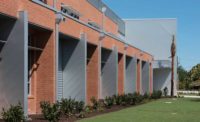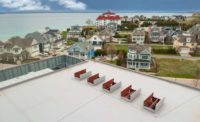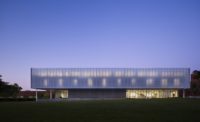The community of Bentonville, Arkansas prides itself on its cultural opportunities, greeting visitors with an assortment of venues. Likewise, the city’s newest venue receives guests with an 80-foot tall glass rainscreen that provides a captivating and unique welcome as people set foot into an astonishingly creative artistic setting.
Manufactured by Bendheim, the glass rainscreen at The Momentary features four design motifs, inspired by traditional Osage Indian clothing to honor the site’s Native American heritage. The new structure, an adaptive re-use of a former cheese factory and a satellite to the nearby Crystal Bridges Museum of American Art, opened to the public in February with a performance by vertical dance troupe BANDALOOP. The dynamic opening performance incorporated projected art and dancers suspended onto the Bendheim glass rainscreen surface. The Momentary is the world’s first building to use Bendheim’s innovative glass rainscreen as a 6,000-square-foot projection surface.
The Momentary is now among the wealth of places where people of all ages can disconnect from devices and soak in art, history, nature, and culinary delights in Bentonville. “When you step into downtown Bentonville,’’ a blogger for Snippykit.com wrote last year, “you will feel like you’ve stepped on a movie set and back in time to a charming town. Bentonville is one of Northwest Arkansas’ best kept secrets, but it won’t be for long.”
Bentonville, popularly known as the headquarters for Walmart, was ranked as the fifth fastest-growing U.S. city earlier this year, according to talkbusiness.net. The community had just 5,508 residents in 1970. 50 years later, the population has soared to approximately 55,000, with nearly 20,000 residents streaming in over the past decade.
As the population has soared, so have cultural amenities. A half-century ago, a trip to Bentonville would have included a trip to Museum of Native American History. There were few other museums at that time. Now, the region is teeming with opportunities, showcasing everything from the embryonic stages of Walmart to the 21C Museum Hotel, which features works of the 21st Century.
Wheeler Kearns Architects of Chicago transformed the space in a two-year project. Only a few people will surmise that seven years ago, the building on which The Momentary now sits served as a cheese processing factory for Kraft foods.
Unforgettable Façade
The façade provides the glamorous bow for the artistic gifts that await visitors inside. The custom-imprinted glass screen features Bendheim’s new LumiFrit™ surface #1 fritted glass, which is optimal for reflecting light and can be customized in a wide range of decorative patterns. The cladding is carefully engineered to attach directly to the cast-in-place concrete, eliminating the need for a steel sub-structure and creating a shadow-free backdrop for projection.
“At The Momentary, every surface is considered a potential canvas for art,’’ project architect Calli Verkamp said. “The Bendheim rainscreen is no different. Not only does the glass have art printed on to it via the frit pattern, but we also wanted to be able to use it as a projection surface for video art. The location and size of the rainscreen make it the perfect backdrop for the project. It’s visible from a long distance given that it is one of the tallest buildings in Bentonville.”
The rainscreen is used as a scrim around a new concrete stair and elevator tower. The LumiFrit™ glass cladding lends the tower a brilliant white aesthetic during the day. At night, the white frit pattern, uniquely applied to the outermost surface of the glass, bounces front-projected light to create a sharp image.
BANDAPLOOP, a pioneer in vertical performance, used The Momentary’s tower as a dance floor during an opening festival in February. Knitting together physicality, choreography and climbing technology, the dancers in essence flipped a dance floor on its side and staged a breathtaking, gravity-defying performance on top of the glass.
A façade that doubles as a digital art canvas is relevant in today’s architectural choices, as outdoor venues are becoming a necessity in promoting culture in a safer and healthier environment.
“This cutting-edge installation heralds a more positive and creative future,’’ said Robert Jayson, President of Bendheim. “We are pleased to see Bendheim glass used in such an unusual and captivating way.”
The system includes patented clip attachments that allow each glass panel to be installed and replaced independently, hastening installing and facilitating maintenance. “This unique quality pushed the owner and us in the direction,’’ Verkamp said. The glass was installed by Advantage Glass of Tulsa, Okla.
Adaptive Reuse
Verkamp and her team took elements that were already in the structure and sought unique and creative ways to incorporate them into the design. “Adaptive reuse is a sustainable method to repurpose standing structures, rather than building completely from scratch,’’ Verkamp said.
“In addition to being a sustainable building method, adaptive reuse serves as a living history, much like contemporary art itself,’’ added Lieven Bertels, director of The Momentary. “The Momentary will be an intersection of art and everyday life. Perhaps some of the original elements and industrial fixtures will inspire artists and the communities to think about their own evolution and this moment in time.”
The Momentary’s inaugural exhibition, State of the Art 2020, opened in an area called “The Galleries,” the oldest part of the original building that stretches across more than 24,000 square feet.
There are artist-in-residence studios, performing arts spaces and a culinary and social space in the Tower, a 70-foot-tall structure that includes intermediate mezzanines. Mezzanine levels are accessible through connecting stairs and a new elevator. There are even outdoor spaces with sculptures, a greenspace, and courtyards. The exterior glass tower adds another showcase to help bring the site to life.
The RØDE House is a multidisciplinary performance space within what used to be the cheese factory’s milk intake room. The space can seat approximately 350 people and includes an adjustable floor that allows the room to be reconfigured quickly from one stage configuration to another. There is also a bar, projection screens and the roof can be fully closed or partially opened for open-air performances.
Fermentation Hall, in the former cheese factory’s fermentation room, features high ceilings, a variable acoustic system, and retractable back seating for more than 100 people. The design takes advantage of the natural acoustic isolation with the precast concrete of the existing space.
History Lesson
For more than 65 years, the location of The Momentary was all about cheese. The plant opened in 1947 before Kraft announced in August of 2012 that it would close the plant, which employed 60 workers.
Bob McCaslin, Bentonville’s then-Mayor and a former 30-year-employee at the factory, said he was sad to see the plant close at the time. “The plant was a steady source of employment through 11 presidents and numerous economic cycles,’’ he said. “We will miss having Kraft as part of our community.”
The site was originally hunting grounds for the Osage Nation, according to information from The Momentary. Graphic artist Addie Roanhorse designed the glass motif on the new building with inspiration from traditional Osage clothing.
The land became an orchard in the 1800s with a railway spur running through the north side of the property. A flour mill occupied the site from 1913-1947 before Kraft came in and opened a 20,000 square foot cheese factory. Over time, its footprint grew to more than 60,000 square feet.
Crystal Bridges announced in 2016 its plan to build The Momentary. Verkamp’s goal throughout the project was to remember the building’s roots. “We wanted to preserve the physical building because that preserves the connection to the past and the community surrounding it,’’ she said in an interview with Arkansas Online.
A Community Transformed
The addition of The Momentary has been part of a transformation that has made Bentonville a cultural oasis in the northwest corner of Arkansas. “Art is a central part of Bentonville’s appeal,’’ VisitBetonville.com says on its website. “Bentonville’s art scene has become a must-do experience for 2020.”
Unlike half a century ago, there is much to see and do in Bentonville. For sure, Walmart is still a huge driver of the community. The Momentary was founded by Walton family, and is based on the vision of Tom, Olivia and Steuart Walton. Olivia, the founding chairperson of the project, is married to Tom Walton, grandson of Walmart founders Sam and Helen Walton. The Walmart Museum, which features Walton’s 5 & 10, an exhibit gallery and more, is one of the other community centerpieces.
The museum of the retailing behemoth, however, is only a piece of the artistic landscape of the fast-growing Arkansas community. There is much more to see and do now, and The Momentary and its striking glass façade from Bendheim add another piece to a dynamic and rapidly evolving cultural haven. It is not New York, Paris, or London, but amenities are on the move in Bentonville. The Momentary is more evidence of that.
“Artists are at the center of everything you see here,’’ Bertels said. “They create the work, they influence our design, they make The Momentary what it is. We are delighted to have this opportunity to spotlight today, the work they are producing, and the role they play in our everyday lives.”






